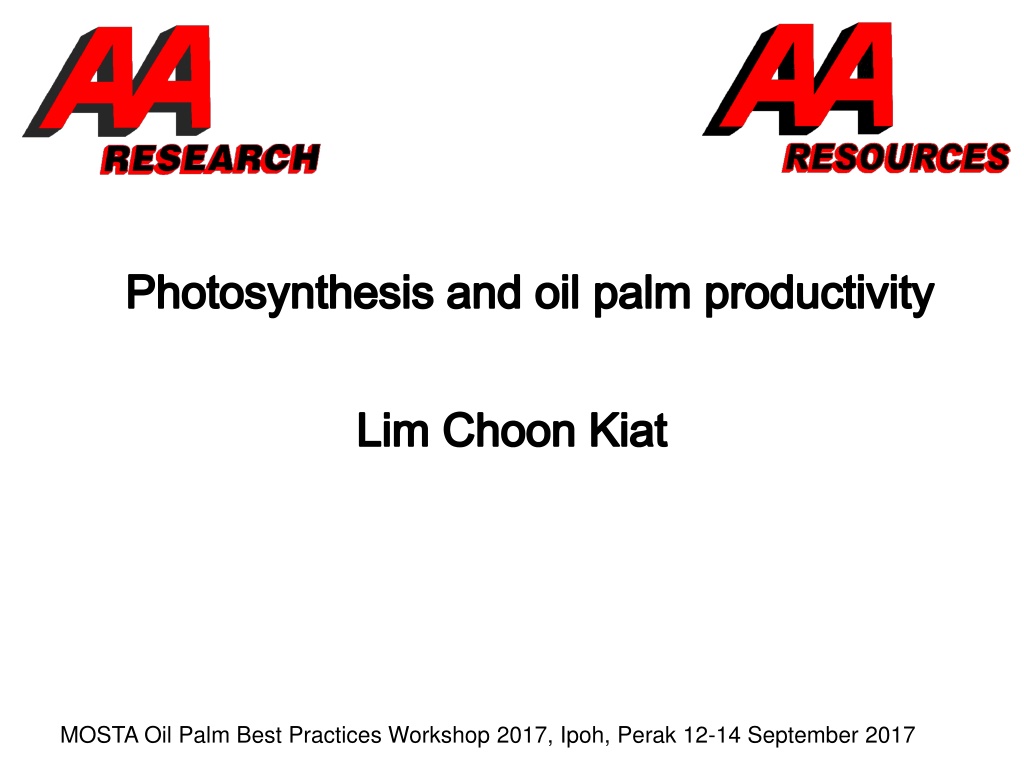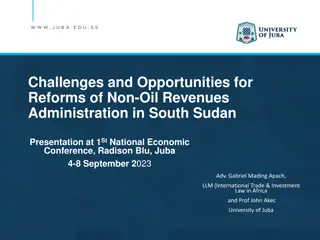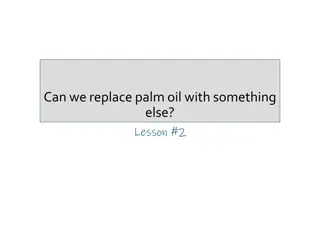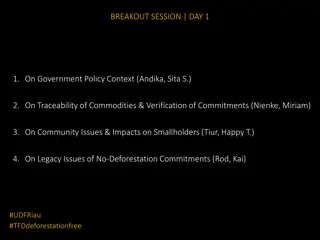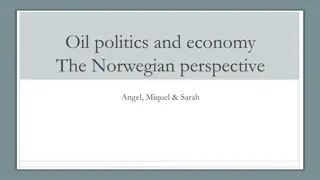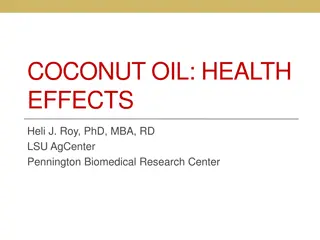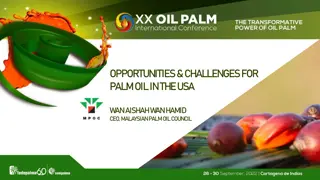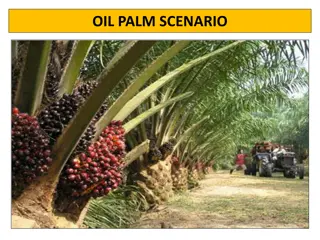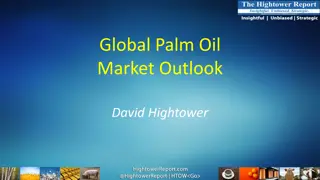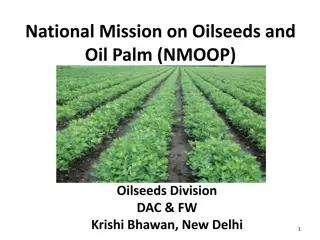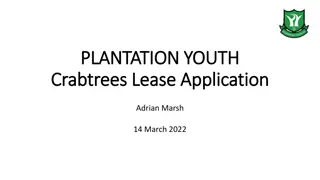Factors Affecting Photosynthetic Efficiency in Oil Palm Plantation
All green plants, including oil palm, rely on photosynthesis to convert carbon dioxide and water into carbohydrates using solar radiation. Key factors influencing oil palm productivity include solar radiation availability, radiation absorption by the canopy, conversion efficiency, dry matter partitioning, and oil yield. Understanding these factors is crucial for optimizing oil palm growth and production. This presentation discusses the impact of photosynthetic efficiency on oil palm cultivation, emphasizing the role of light capture, canopy development, assimilate allocation, and partitioning of resources for optimal productivity.
Uploaded on Sep 22, 2024 | 0 Views
Download Presentation

Please find below an Image/Link to download the presentation.
The content on the website is provided AS IS for your information and personal use only. It may not be sold, licensed, or shared on other websites without obtaining consent from the author. Download presentation by click this link. If you encounter any issues during the download, it is possible that the publisher has removed the file from their server.
E N D
Presentation Transcript
Photosynthesis and oil palm productivity Lim Choon Kiat MOSTA Oil Palm Best Practices Workshop 2017, Ipoh, Perak 12-14 September 2017
Source: Goh et al., 2014 Yield Definitions & Site Yield Potential (SYP) Potential Yield: Theoretical maximum yield ~18.5 t/h/y Oil 1) Yield defining factors: Genetic Yield Potential : Max. yld. obtainable without any environmental, agronomy and management constraint I. Potential yield Physiological parameters ~45 t/h/y FFB Four production levels: - Small trial plots Climate, soil, terrain, density 2) Yield limiting factors: Site Yield Potential : Maximum yield realizable, given a set of site characteristics II. Genetic yield potential - < 1% of area ~35 t/h/y FFB 3) Yield reducing factors: III. Site yield potential Mainly agromanagement e.g. nutrition, drainage, canopy damage etc. Yield Gap ~ 20% Mainly management e.g. poor IV. Actual yield 4) Yield loss factors: harvesting standards, recovery etc. ~28 t/h/y FFB Actual Yield: Yield that can be recovered from the field 2
Introduction 1) All green plants fix carbon dioxide by photosynthesis to form dry matter of plant tissues. 2) The energy supply for photosynthesis comes from solar radiation. 3) The energy absorbed by chlorophyll of leaves to convert carbon dioxide and water to carbohydrate (sugar).
4) Therefore, the key factors in understanding plant growth and production are: i) The total amount of solar radiation (S) available ii) The fraction of radiation intercepted & absorbed (f) by the canopy iii) The efficiency of conversion (e) into carbohydrates iv) The partitioning of dry matter between vegetative growth and yield of fruit bunches (H) v) The partitioning of carbohydrates in mesocarp into palm oil Mathematically, FFB yield = S.f.e.H 5) The main objective of this presentation is to discuss factors affecting photosynthetic efficiency in oil palm.
Schematic diagram of oil palm photosynthesis and productivity capture photosynthesis respiration Light Canopy Assimilates Maintenance development Canopy Growth allocation allocation Trunk Vegetative Generative partitioning partitioning Roots Male flowers Bunches Others Palm oil Kernel
Light capture (f) 1) Solar radiation is the only source of energy for photosynthesis. 2) Only part of incoming radiation is utilised by plants. Photosynthetically Active Radiation (PAR) [between 380 to 700 nm] Graph of the amount of power the sun radiates at different wavelengths (upper line) and that which reaches the Earth's surface (lower line) 3) The fraction of light captured depends on a) Leaf area b) Number of fronds c) Planting density Leaf area index (LAI)
Relationship between leaf area index (LAI) and light interception S = 3.41422389 r = 0.99511712 99.00 Light interception, f (%) 82.50 Maximize: a) Leaf area b) Number of fronds c) Planting density 66.00 49.50 33.00 16.50 0.00 0.0 1.5 2.9 4.4 5.9 7.3 8.8 Leaf area index At an LAI of 4.5 interception of PAR is at least 80%, increasing up to 90 95% at an LAI of 6 7. Yields are reduced when LAI exceeds an optimum value of 6 due to competition among palms. The primary aim is to obtain a LAI between 6.0 and 6.5 in the shortest possible time from planting and sustain it. (Squire, 1984; Breure, 1985; Woittiez et al., 2017)
Radiation use efficiency (e) 1) Photosynthetic rate increases with the intensity of PAR. Influenced by: a) Soil water content b) Vapour pressure deficit c) Nutrients d) Temperature e) Respiration rate f) Planting material A, umol m-2 s-2 PAR, umol m-2 s-2 Response of photosynthesis (A) to photosynthetically active radiation (PAR) The amount assimilates = the fraction of light capture (f) x radiation use efficiency (e) Dufrene et al., 1990; Corley & Tinker, 2003; Lamade, 2005
Influence of nutrients, planting materials on photosynthesis Material 6 Photosynthesis rate of various oil palm planting materials subjected to different fertiliser rates. The influence of fertiliser levels on photosynthetic rate and total biomass. Nitrate reductase activity in oil palm fronds of different planting materials subjected to different fertiliser rates (Shaari, 2017) Right planting material & fertiliser rate can maximise photosynthetic rate
Optimal level of light interception for effective photosynthesis Leaf orientation with respect to light angle can modify light interception (palm etiolation). Increase in light interception will decrease light transmission or light intensity (PAR) and thus, reduce photosynthesis. FFB in dry weight Light capture
Effect of number of fronds per palm on photosynthesis The increases rapidly between 9 and 33 fronds retained. amount of light capture Light capture The light conversion efficiency was high for the 1st whorl of leaves but declined by more than 60% at the start of the 3rd whorl of leaves. Light conversion efficiency
Sugars distribution in oil palm canopy Figure shows the variation of soluble sugar contents across the leaf ranks (Frond number) Sucrose Main results: 1) Frond number 6 or younger are sink i.e. do not produce sufficient sugars to sustain/maintain their growth. 2) Frond 40 and older are self sustaining i.e. don t contribute to higher yield. 3) Sugars are mainly in the forms of glucose and fructose. Glucose Fructose Total sugars Understanding of the sugar distribution provides insights in oil palm pest management. Lamade et al., 2009 Leaf rank
Partitioning of assimilates 1) Dry matter production (Growth) = Assimilates Respiration 2) The dry matter produced is then partitioned into: a)Vegetative growth b)Reproductive (Generative) growth respirationMaintenance capture photosynthesis Light Canopy Assimilates Growth Growth (Dry matter) Vegetative Generative
Partitioning of vegetative growth 1) Vegetative dry matter (VDM) is relatively unaffected by abiotic stresses. But, a small reduction in VDM can have a big impact on yield. 2) For example, a) VDM declined significantly with higher density for clonal palms but yield declined even more. b) Severe pruning decreased VDM by 4% but reduced yield by 65%. c) Removal of 75% of inflorescences increased VDM by 5% but reduced yield by 45%. Most of the increased in VDM was in the trunk. 3) Estate management must maintain the palm canopy at all times.
VDM can be partitioned into canopy, trunk and roots respirationMaintenance capture photosynthesis Light Canopy Assimilates Most important feedback mechanism Growth Growth (Dry matter) Canopy Parameters a) Frond production b) Leaf area c) Leaf weight Vegetative Generative Trunk Roots Water Nutrients Fruiting activity Pest and disease Management e.g. pruning Dominant limiting factors
Partitioning of reproductive (generative) dry matter respirationMaintenance capture photosynthesis Light Canopy Assimilates Growth Growth (Dry matter) Canopy Vegetative Generative Trunk Roots Male flowers Bunches 1) Most of the reproductive dry matter is partitioned to bunches. 2) Normally, <= 5% is utilised for male inflorescences. Dominant factors 1) Palm age 2) Water 3) VPD 4) Fruiting activity 5) Photoperiod Corley & Gray, 1976; Caliman 1992; Legros et al., 2009
Palm oil yield respirationMaintenance capture photosynthesis Light Canopy Assimilates Growth Growth (Dry matter) Canopy Vegetative Generative Trunk Major factors 1) Transpiration rate 2) Glycolysis 3) Potassium 4) Temperature 5) Bunch size 6) Light Male flowers Bunches Roots Others Palm oil Kernel Corley, 1976
Conclusions 1) Photosynthesis is a crucial determining factors of oil palm yield. 2) Right planting materials, fertiliser rates and planting density can maximise photosynthetic efficiency. 3) We must also provide the best growing environment for the palms and prevent loss of palms or leaf area e.g. through pest and disease, and over pruning. 4) Most of the abiotic stresses that reduce FFB yields and oil formation are controllable or can be mitigated e.g. soil and water conservation.
